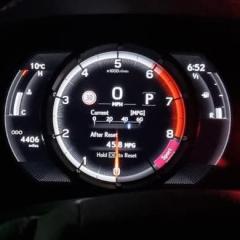Leaderboard
Popular Content
Showing content with the highest reputation on 09/22/2016 in all areas
-
An LS is like being addicted to caffeine, it makes you feel good, you can give it up, but life will never be the same again. Having a modern frugal fuel beast is like having too many pints of Stella, you never know when things might get nasty2 points
-
I'm not a fan of these high power tiny engines. I think it's much better to have a large unstressed motor rather than a tiny one constantly working it's balls off. I've had my fair share of problems with modern diseasels. A Diesel engine used to mean economy, reliability and we're as tough as old boots that just keep going and going. Now they are plagued with issues like EGR problems, DMF problems, DPF problems, injector problems, turbo problems to name a few. Only the EGR is relatively cheap, the rest are 4 figure repair bills and at the end of the day it still drives and sounds like Massey ferguson no matter how good it is or how much you spend on it. My mk4 is 17 years young with 164k on the clock and still feels right and tight with everything working as it should. Nothing even comes close to this car in my opinion, I just hope it still has lots of life left in it (I'm confident it has) because whatever replaces when the day eventually comes will be a downgrade. Perhaps a facelift LS430 would replace it one day.2 points
-
I believe there is a fee after 12 months according to my handbook (a very reasonable rate) it states.1 point
-
I loved my previous IS 300h Fsport but found the suspension a bit to firm hence why I now have a GS luxury spec. The GS is another league up from the IS in build quality quieter and more comfortable. Little extras like an auto handbrake ambient lighting in the door panels, blind spot warning all LED interior lighting are a few things I have noticed. Ed1 point
-
I just thought I'd document my experiences with the evaporator drain on my 2006 GS450h. Apologies in advance for the long post... I first noticed the issue when I found that condensation was appearing on the inside of the windows of the car. This is always a sure sign that there is water in the interior of the car. Initial searches failed to find anything until I decided to lift the rear carpets of the car. When I did so I found the sound deadening foam and underside of the carpet completely saturated. This is a common enough phenonmen due to the waterproof nature of the carpets preventing such water reaching up. There was probably 1.5 litres of water in total in each side. Having researched the issue through the web, I found that the air-con evaporator drain on the 2006 GS models is a known issue, with the drain becoming blocked and the condensate, which would normally puddle under the car, instead drains directly into the car interior. In hindsight, I don't recall ever seeing a pool of condensate under the car in the past. I was lucky (I think) that only the rear carpets were wet. The carpets and underlay under the front seats was mostly dry. There are many great posts on the various Lexus sites describing the issue and detailing how it can be addressed. The evaporator drain is on the "roof" of the transmission tunnel and is designed to allow the water to drain onto the gearbox and run down to the ground. There are a number of TSBs from Toyota and the latest ones describe how to remove the offending drain grommet by yanking it out with a pliers from below the car. I think the most recent TSB for this issue is the following: http://st.club-lexus(blocked word)/attach/u/7cff5226.pdf While this can be done for the IS and GS300 and GS350 models, it seems the fix for the GS450h remains to remove the evaporator unit and replace the drain grommet with a new one. This requires complete removal of the dash and console and was not an option for me. The method recommended in the TSBs for the IS and GS models is to disconnect the exhausts, loosen the rear gearbox crossmember and lower the rear of the gearbox until the grommet can be accessed and removed with a set of long pliers. Some people have commented that it is possible to remove the grommet without lowering the gearbox or loosening the exhaust. Having worked on the GS450h, I believe this option of lowering the transmission will probably not work for the 450h. The "gearbox" on the 450h appears to almost completely fill the transmission tunnel. In addition, the GS450h has a cladding on the interior of the tunnel, further restricting access. This cladding is about 10mm thick and is bonded to the tunnel and does not appear to be fitted to the IS or other GS models. There is about 15mm of clearance along the sides of the gearbox. Even if the gearbox was lowered and the heatshields removed, I don't think it would be possible to reach around the gearbox to access the grommet as the gearbox on the GS450h is very tall. Here's what I did. I was lucky to have access to a pit to do this work, but a 4-post lift of some kind would be even better. I removed the lower tray under the gearbox (2 nuts, 4 screws). The first challenge is to locate the position of the grommet. It is not possible to see it directly at all from under the car. I used the "endoscope" I bought from Lidl some time ago to locate the grommet. The position as detailed in the TSBs is confusing and I was eventually able to find two photographs on the web which helped me locate the position. For reference, the grommet is in the roof of the tunnel, roughly in line with the support bar providing support to the exhausts. In the attached photos, you can see the flexible portion of the boroscope taped to the support bar for the exhausts. If this sounds easy, it took me one day to locate the grommet with the endoscope! Part of this was because I did not know where to look and partly to the quality of the Lidl endoscope (I think it was €75 a couple of years ago). The Lidl boroscope requires that the camera is about 10mm from the area you want to look at. I imagine a better quality scope would provide better lighting and have a camera that would allow a wider view. I believe the cladding on the transmission tunnel also makes it more difficult as the grommet is further recessed in a cutout of this cladding compared to cars without the cladding. I taped the scope in position when I had the grommet in view as even the smallest move meant the grommet disappeared from view! Once I had the grommet in view, I then had to access it. I first used a long gas welding rod to create a tool I could use to probe for the grommet. To access the grommet, it was easier to come from the front of the gearbox, coming from the alloy crossmember, and feeding the wire across the top of the gearbox. I don't think it would be possible to do this from the side of the gearbox. When I located the grommet with the wire (quick to say, but it took at least an hour to even see the end of the rod in the boroscope screen...), I touched the grommet and about 1/2 cup of water came out! I don't think the grommet was blocked with debris, but had just sealed itself, perhaps due to little use of the car over a period of weeks. It might be the case that closing all the vents, stopping the heater channels under the front seats and turning the fan up full might have opened the drain.... Even given the access and means to reach it, it would be still impossible to remove the grommet. I just needed to rip it up as much as possible. To do this I created another tool using copper brake pipe I have from other projects. I basically replicated the shape of the initial tool and flattened and created a barb on the end of the tool to rip the grommet. The copper piping allowed the tool to be stiffer than the welding row, but with enough flexibility to allow it to be manvoured into place. With practice, I could locate the grommet first time, almost! Coming from the front of the gearbox allowed me to use my hand higher up to brace the piping as I moved the end of the pipe to rip the grommet. I think I was able to rip the grommet sufficiently so that it won't be a problem again. After I did all this, I ran the air-con at full cooling and was pleased to see a stream of water from the drain.1 point
-
The car starting the engine when you power on will be due to quite a few factors. Is it cold and are the wipers, heated seats, heater or A/c, heated rear window and lights on. These are a major draw and the engine is likely to power on. Also temperature can be a factor and also what charge the battery was at when you last parked up. Is the last part of your journey home always on battery meaning battery is largely depleted when you switch off. Many many factors.1 point
-
1 point
-
1 point









